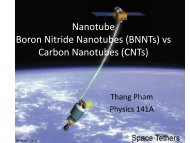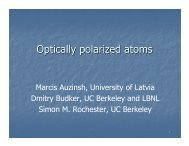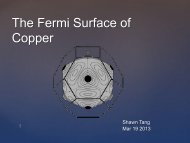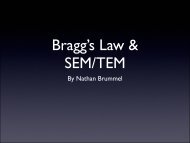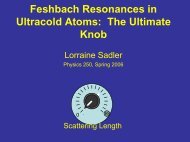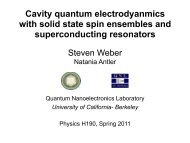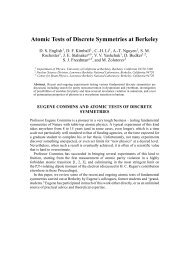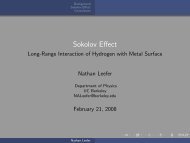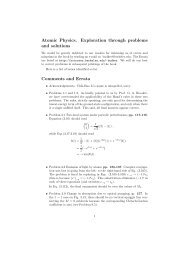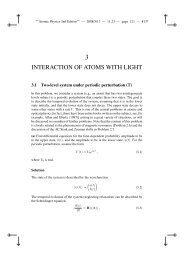Resonant nonlinear magneto-optical effects in atomsâ - The Budker ...
Resonant nonlinear magneto-optical effects in atomsâ - The Budker ...
Resonant nonlinear magneto-optical effects in atomsâ - The Budker ...
You also want an ePaper? Increase the reach of your titles
YUMPU automatically turns print PDFs into web optimized ePapers that Google loves.
39<br />
Photodiode signal (V)<br />
10<br />
8<br />
6<br />
4<br />
2<br />
0<br />
7<br />
6<br />
5<br />
4<br />
33.0 33.2 33.4 33.6 33.8 34.0<br />
0 20 40 60 80 100 120 140<br />
Time (s)<br />
FIG. 20 Experimental <strong>optical</strong> rotation signal obta<strong>in</strong>ed by Romalis<br />
et al. (2001b) produced by Hg atomic polarization <strong>in</strong> a<br />
magnetic field of 17 mG. <strong>The</strong> <strong>in</strong>set shows a one-second segment<br />
of the data.<br />
from resonance by 20 GHz, is detected (Fig. XII.B). 35<br />
<strong>The</strong> sp<strong>in</strong>-precession frequency is measured <strong>in</strong> two identical<br />
cells with opposite directions of the electric field<br />
with respect to the magnetic field. This device has a<br />
sensitivity to energy level shifts of ∼0.3 µHz/Hz 1/2 over<br />
a measurement time of a hundred seconds, better than<br />
any other exist<strong>in</strong>g device (see Sec. XII.A). With several<br />
months of data tak<strong>in</strong>g, it has set a limit on the atomic<br />
EDM of ∣ ∣d ( 199 Hg )∣ ∣ < 2.1×10 −28 e cm (95% confidence).<br />
C. <strong>The</strong> Aharonov-Casher phase shift<br />
<strong>The</strong> Aharonov-Casher effect was studied <strong>in</strong>terferometrically<br />
with neutrons (Cimm<strong>in</strong>o et al., 1989) and<br />
with the fluor<strong>in</strong>e nucleus <strong>in</strong> the TlF molecule (Sangster<br />
et al., 1993, 1995) us<strong>in</strong>g conventional Ramsey molecular<br />
beam spectroscopy. Faraday-Ramsey spectroscopy<br />
(Sec. VIII.C) is a convenient method for measur<strong>in</strong>g the<br />
Aharonov-Casher effect with atoms. Gorlitz et al. (1995)<br />
performed such an experiment with Rb atoms and found<br />
agreement with the theoretical prediction at the level<br />
of 1.4%. <strong>The</strong>y verified the l<strong>in</strong>ear dependence of the<br />
phase shift on the strength of the electric field as well<br />
as its nondispersive nature (<strong>in</strong>dependence of velocity).<br />
An atomic Aharonov-Casher effect was also measured by<br />
Zeiske et al. (1995) us<strong>in</strong>g an atomic <strong>in</strong>terferometer.<br />
In Faraday-Ramsey geometry, the phase shift accumulated<br />
<strong>in</strong> a homogeneous static electric field between<br />
∆M = 2 sublevels of an aligned atom is given by<br />
φ AC = 2gµ<br />
¯hc<br />
∫<br />
EdL, (37)<br />
where the field <strong>in</strong>tegral extends over the flight region between<br />
the two <strong>optical</strong> <strong>in</strong>teraction regions. This phase<br />
shift enters directly <strong>in</strong> the Faraday-Ramsey l<strong>in</strong>e-shape<br />
function given by Eq. (26). When us<strong>in</strong>g atoms with a<br />
well known g-factor, the measurement of φ AC can thus<br />
be used to experimentally determ<strong>in</strong>e the electric field <strong>in</strong>tegral<br />
(Rasbach et al., 2001).<br />
D. Measurement of tensor electric polarizabilities<br />
<strong>The</strong> quadratic Stark effect <strong>in</strong> a Zeeman manifold<br />
|F, M〉 <strong>in</strong> a homogeneous static electric field E can be<br />
parameterized by<br />
An atom mov<strong>in</strong>g <strong>in</strong> an electric field E with velocity v<br />
experiences a magnetic field B = E × v/c. This “motional”<br />
magnetic field <strong>in</strong>duces phase shifts of the atomic<br />
magnetic sublevels and thus affects <strong>nonl<strong>in</strong>ear</strong> <strong>magneto</strong><strong>optical</strong><br />
signals. <strong>The</strong> E × v effect is a l<strong>in</strong>ear Stark effect<br />
that represents a severe systematic problem <strong>in</strong> many<br />
EDM experiments. <strong>The</strong> <strong>in</strong>duced phase shift is given by<br />
the Aharonov-Casher (1984) phase<br />
φ AC = 1<br />
¯hc<br />
∫<br />
(c)<br />
µ × E(s) · ds (35)<br />
acquired by a magnetic moment µ carried on a path (c). 36<br />
<strong>The</strong> phase (35) is <strong>in</strong>dependent of the shape of the trajectory<br />
(c) and is thus referred to as a “topological phase”.<br />
∆ s (F, M) = − 1 2 αE2 , (38)<br />
where the static electric polarizability α can be decomposed<br />
<strong>in</strong>to scalar (α 0 ) and tensor (α 2 ) parts accord<strong>in</strong>g to<br />
(Angel and Sandars, 1968):<br />
α = α 0 + 3M 2 − F (F + 1)<br />
F (2F − 1)<br />
α 2 . (39)<br />
States with J = 1/2, such as the alkali ground states,<br />
can only have tensor properties due to nonzero nuclear<br />
sp<strong>in</strong>. Tensor polarizabilities of such states are suppressed<br />
compared to the scalar polarizabilities by the ratio of the<br />
hyperf<strong>in</strong>e splitt<strong>in</strong>g to the energy separation between the<br />
35 A previous (several times less sensitive) version of this experiment<br />
(Jacobs et al., 1995) used the same light beam for both<br />
pump<strong>in</strong>g and prob<strong>in</strong>g.<br />
36 Equation (35) can be easily derived by consider<strong>in</strong>g a particle with<br />
magnetic moment mov<strong>in</strong>g along a trajectory whose element is<br />
given by ds = vdt. <strong>The</strong> particle acquires a differential phase shift<br />
dφ = · B<br />
¯h<br />
dt = · E × v<br />
¯hc<br />
which gives (35) upon <strong>in</strong>tegration.<br />
dt = · E × ds , (36)<br />
¯hc





